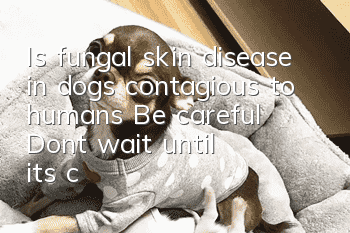Is fungal skin disease in dogs contagious to humans? Be careful! Don’t wait until it’s contagious and you realize it

Pathological characteristics of fungal skin diseases in dogs
There are many types of pet skin diseases, and fungal skin diseases are one of them, also known as dermatomycosis. It is a variety of skin diseases caused by dermatophytes that invade the skin, hair and toes, as well as the keratin tissue of the claws. ”Currently, five fungi have been found to cause dermatophytosis in cats and dogs: Microsporum canis, Microsporum gypseum, Trichophyton mint, Microsporum dudan and Microsporum mutans. Among them, Microsporum canis Microsporum spores are the most common, followed by Microsporum gypseum, Trichophyton menttis and Microsporum tudan. Micrococcal mutagens are only found in a few countries such as Australia, and the incidence is low. Fungal skin diseases in cats are mainly caused by canine microorganisms. Caused by spores.
“Too many professional terms and don’t want to read? It doesn't matter, you just need to understand this sentence: This disease is a zoonotic infectious disease, and human doctors collectively call it "ringworm". Therefore, when pets suffer from skin diseases, they must be treated and cared for in time to be careful of infecting yourself and your family! "
"Usually the entire process of acute infection lasts 2 to 4 weeks. If not treated in time, it will become chronic. Chronic diseases are difficult to cure, some can last for several months, and they are easy to relapse! ”
Why do you get fungal skin diseases?
1: Direct or indirect contact with cats, dogs, or people suffering from fungal skin diseases
Dermatophytes have strong survivability and resistance. They can parasitize animals and plants, and are spread in the air with dust. There are many opportunities for transmission, mainly through contact. However, contact with contaminated utensils, combs, scissors, mats etc. may also lead to indirect infection2: Related to climate, age and body constitution
The incidence rate in hot and humid climates is higher, young animals are more susceptible to infection than adult animals, and malnourished animals are more nutritious than Animals are more susceptible to infection.A simple diagnosis of fungal skin disease
If you notice that your pet is itching, scratching or licking the skin excessively, be sure to remove its fur. Take a look. If you see some obvious symptoms of papules, pustules or peeling and hair loss, it means it may have a skin disease.However, we still need to analyze specific skin diseases based on specific symptoms before we can Correct drug treatment. Once you suffer from fungal skin diseases, you can often see clear boundaries on the skin, such as corner-sized hair loss spots with fluid leakage; non-circular, non-characteristic hair loss lesions will have sticky blood and erythema; skin Red, swollen, scaly, and small nodules may appear. This is caused by scratches on pets.
If infected with Trichophyton mentagrophytes, it can also cause onychomycosis in dogs, resulting in dry, cracked, brittle and deformed nails. Symptoms.
How to prevent it in daily care?
1: Stay away from pathogens
Pets’ living environment should be disinfected regularly, and management should be strengthened to avoid contact withIf pets are exposed to sick cats or dogs and are found to have skin diseases, they should be isolated and treated immediately.2: Check in time
When bathing or combing your dog, use your hands to carefully touch the pet's body to feel for scabs and protrusions. If there is any abnormality, check it in time. Clear diagnosis and treatment.3: Bath regularly and pay attention to blow drying
Pay attention to the pet's physical hygiene, bathe regularly, and use pet-specific bath liquid. Be sure to blow dry carefully after bathing, especially in the spaces between your armpits, claws, and fingers. Excessive moisture is a breeding ground for mold and fungi.4: Eat a healthy and balanced diet
Choose nutritious dog or cat food, try to avoid feeding a single food, and pay attention to supplementing various vitamins, minerals and trace elements to enhance your pet’s resistance. force.5: Frequently bask in the sun
Ultraviolet rays in the sun can kill a certain amount of mold, so you should often take your pet to bask in the sun, and of course, be careful not to get sunburned.How to treat fungal skin diseases?
The types of skin diseases are complex and easy to cause mixed infections. Even the most professional pet doctor cannot tell which skin disease your baby has at a glance. It is best to go to the hospital for a relevant skin test, including Microscopic examination of scrapings, ultraviolet detection of fungi, and fungal culture can be used to prescribe the right medicine after confirmation.Once it is confirmed that your pet is suffering from fungal skin disease, measures should be taken for treatment and care!
1: Treat the affected area
First clean the area affected by the fungus, wash away the dander and scabs, and shave the hair on the affected area (if there is a large-scale infection all over the body, consider shaving the whole body), which can not only help the medicinal solution Penetration and prevention of continued spread.2: Use medication with caution
When applying topical medication, apply it over a slightly wider area to inhibit the spread of fungi. If your pet suffers from a chronic and severe skin disease, you need to take oral treatment drugs at the same time.3: Environmental disinfection
While treating, don’t forget to disinfect the pet’s living environment, pay attention to public health, and prevent the spread from pets to people and people to pets.Pet dermatophytes are relatively stubborn and require a long treatment period. Owners must be patient and confident. Don’t be anxious. Be careful that “haste makes waste”!
Random articles
- Can dogs eat dates? Feeding some dates in moderation can still have some effects!
- Comprehensive list of medium-sized dog breeds. Do you know all of these dogs?
- Can dogs eat pig lungs? Don’t do it too often!
- Which formula of Bowang dog food should you choose? Which formula is the most nutritious and suitable for dogs?
- How to remove dog tear stains. If you want to avoid tear stains, your behavior is very important!
- Benefits of inbreeding in dogs Can dogs be inbred?
- How to prevent your dog from getting lost? Try these three tricks
- Dog vomits after vaccination. Is this reaction normal?
- How to arrange dog furniture? Three things to note when designing pet living areas
- How to deal with tangled dog hair. Owners must learn these tricks



